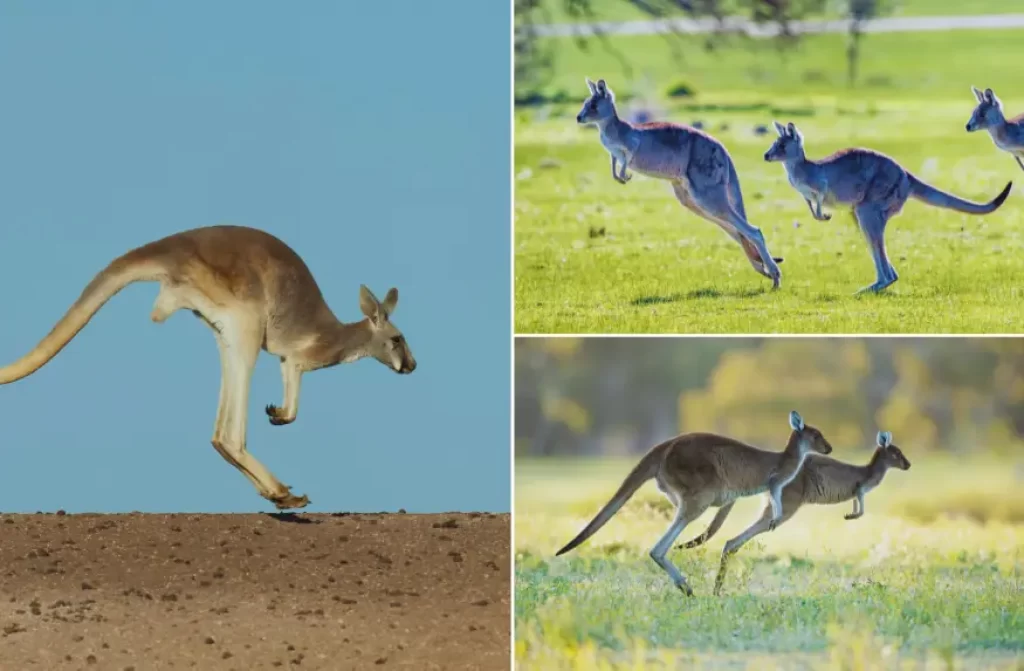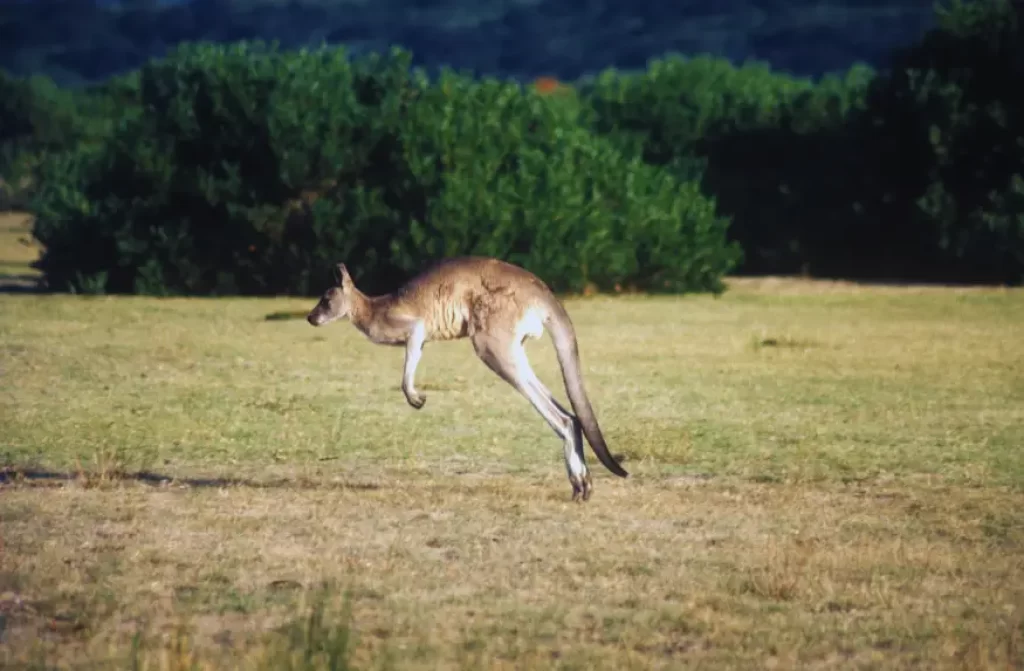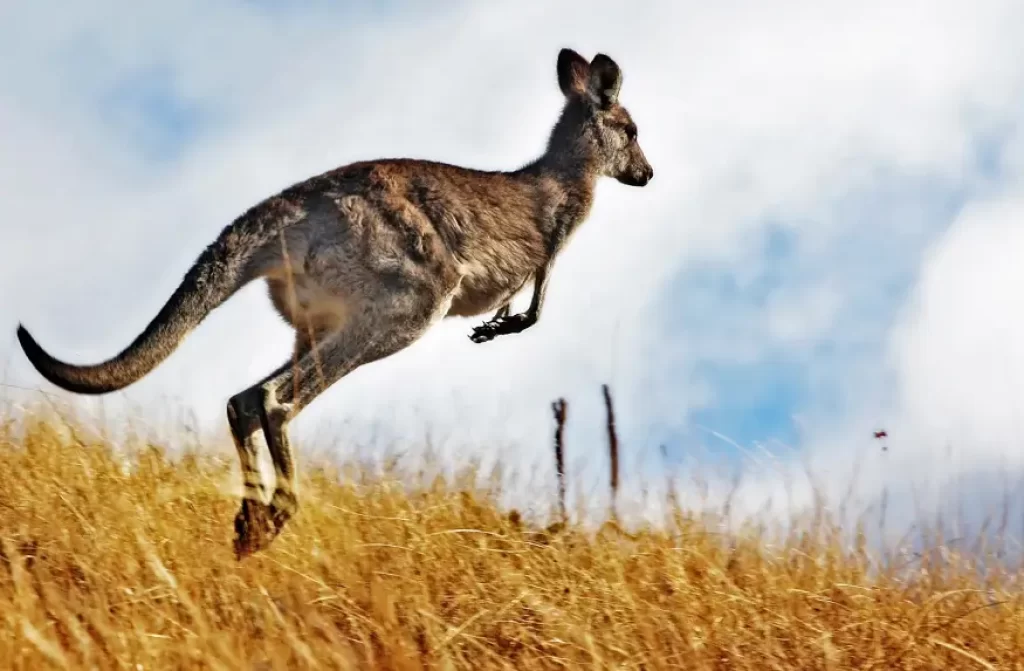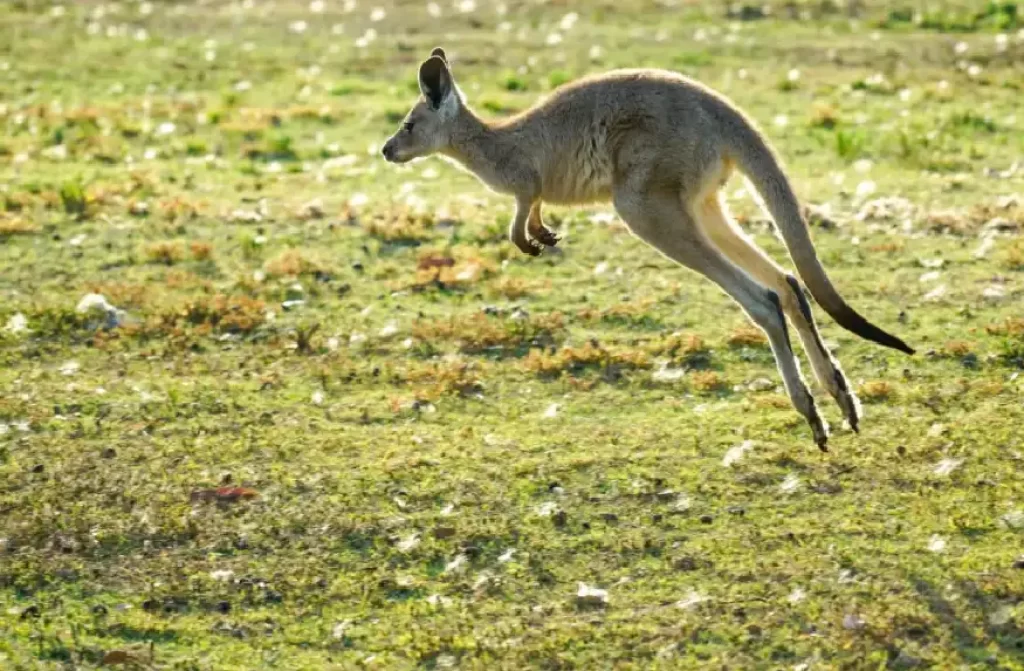Kangaroos, those iconic marsupials native to Australia, are known for their unique mode of locomotion—hopping. While most animals move by walking, running, or jumping, kangaroos have perfected the art of hopping, which sets them apart from other mammals.
This distinctive form of movement allows kangaroos to cover vast distances efficiently, conserve energy, and adapt to their specific environment. In this article, we delve into the reasons behind kangaroos’ preference for hopping over jumping and explore the incredible adaptations that enable them to do so.
Energy Efficiency

Hopping, as opposed to jumping, is an energy-efficient method of locomotion for kangaroos. The kangaroo’s hopping gait allows it to conserve energy while traveling long distances.
Unlike jumping, which involves propelling oneself off the ground with both hind legs simultaneously, hopping is a more sustainable and rhythmic movement that requires less energy expenditure.
By using their muscular tails as a pivot point and using their powerful hind legs to push off the ground, kangaroos can maintain a steady pace without exhausting themselves.
Adaptation to the Environment
Kangaroos inhabit diverse environments, ranging from arid grasslands to dense forests. Their hopping ability is a remarkable adaptation that enables them to navigate and thrive in these varied habitats.
In open grasslands, hopping allows kangaroos to cover large distances quickly, escaping potential predators while foraging for food.
The kangaroo’s long hind limbs and strong leg muscles are well-suited for this type of locomotion, allowing them to clear obstacles, such as fallen trees or tall grasses, effortlessly.
Protection and Defense

The kangaroo’s hopping technique also serves as a form of defense and protection. When threatened or pursued by predators, kangaroos can reach remarkable speeds of up to 40 miles per hour (64 kilometers per hour) in a series of powerful hops.
By using their strong legs and tails, kangaroos can evade danger effectively. Hopping allows them to swiftly change direction, making it difficult for predators to catch up. The kangaroo’s hopping ability combined with their sharp claws and powerful kicks make them formidable opponents when defending themselves or their young.
Efficient Respiration
Another advantage of kangaroos’ hopping gait lies in its impact on respiration. Unlike jumping, where the body leaves the ground entirely, hopping ensures that at least one foot remains in contact with the ground at all times.
This continuous contact aids in stabilizing the kangaroo’s body and facilitates efficient respiration. As the kangaroo exhales during a hop, the landing foot helps absorb the impact and prevents excessive strain on their respiratory system. This unique adaptation allows kangaroos to sustain their hopping motion over long periods without experiencing fatigue.
Calling all fellow kangaroo enthusiasts! If you, like me, have a deep love for these incredible creatures, you’re in for a real treat. Take a moment to explore this article that delves into the fascinating world of the Red Kangaroo. 🦘
Do kangaroos do hops or trots?

Kangaroos are famous for their incredible hopping abilities, which are their primary mode of locomotion. So, the short answer is that kangaroos do hops, not trots. But let’s dive deeper into the fascinating world of kangaroo locomotion to understand why hopping is their preferred method.
Picture this: You’re strolling through the Australian outback, and suddenly, you spot a kangaroo in the distance. As it gracefully moves towards you, you might notice that its movement resembles a hop rather than a typical trot. This hopping motion is what sets kangaroos apart from other animals and makes them so unique.
When a kangaroo hops, it uses its powerful hind legs to propel itself forward while keeping its forelimbs tucked close to its body. This distinctive style of locomotion is incredibly efficient and offers several advantages for kangaroos in their natural environment.
Firstly, hopping allows kangaroos to cover vast distances quickly while conserving energy. Unlike a trot, where an animal needs to maintain a constant pattern of alternating diagonal pairs of feet touching the ground, hopping is a more energy-efficient method.
By using their muscular tails as a pivot point, kangaroos can leverage their strong hind legs to push off the ground in a rhythmic and sustainable manner.
Furthermore, hopping is an adaptation that enables Kangaroos 🦘 to navigate different terrains. Whether they’re hopping through open grasslands or densely forested areas, this mode of locomotion allows them to clear obstacles and move swiftly. With their long hind limbs and powerful leg muscles, kangaroos can effortlessly negotiate uneven surfaces and overcome barriers like fallen trees or tall grasses.
Hopping also serves as a means of protection and defense for kangaroos. When faced with potential predators, kangaroos can reach impressive speeds of up to 40 miles per hour (64 kilometers per hour) in a series of powerful hops.
This agility, combined with their sharp claws and formidable kicks, makes them highly adept at evading danger and defending themselves or their young.
So, while kangaroos don’t trot like some other animals, their hopping ability is a marvel to behold. It’s a skill that has evolved over time, enabling them to excel in their unique Australian habitat. Next time you encounter a kangaroo, take a moment to appreciate their graceful and efficient hops—a reminder of the incredible diversity and adaptability of our natural world.
You might also like: How do Kangaroos Protect Themselves from Predators?
Can kangaroos hop if you lift their tail off the ground?

No, kangaroos cannot hop if their tail is lifted off the ground. The tail plays a crucial role in their hopping motion and acts as a pivot point. It provides balance and stability as they propel themselves forward with their powerful hind legs.
The kangaroo’s tail is not just a simple appendage; it’s a muscular structure that helps them maintain their posture and control their movements during hopping. Without the support of their tail on the ground, kangaroos would lose their balance and struggle to execute their characteristic hops effectively.
In addition to balance, the kangaroo’s tail also serves other essential functions. It acts as a counterbalance during rapid turns and sudden changes in direction, allowing the kangaroo to maintain agility while hopping. The tail also aids in communication, serving as a signal for social interactions among kangaroos.
So, to witness kangaroos in their full hopping glory, their tails must remain in contact with the ground, providing them with the stability and coordination they require to execute their incredible hopping motion.
You might also find interesting: Human vs Kangaroo: Who Wins the Ultimate Fight?
What to do if a kangaroo jumps in front of you?

Encountering a kangaroo unexpectedly can be a surprising and potentially dangerous situation. Here are some steps to follow if a kangaroo jumps in front of you:
Stay calm and avoid sudden movements
It’s important to remain calm and composed. Sudden movements or loud noises may startle the kangaroo further, potentially escalating the situation. Try to maintain a safe distance and avoid any actions that might provoke or agitate the animal.
Give the kangaroo space
Kangaroos typically hop away when they feel threatened or perceive a potential danger. Back away slowly, giving the kangaroo plenty of space to move away from you. Avoid cornering or blocking the kangaroo’s escape route, as this may make it feel trapped and more likely to act defensively.
Maintain eye contact
Keep your eyes on the kangaroo while slowly backing away. Eye contact can help establish a sense of dominance and may discourage the kangaroo from approaching or escalating the encounter.
Do not turn your back or run
Turning your back or running away from a kangaroo can trigger its prey instinct, causing it to give chase. Kangaroos are fast and powerful, capable of reaching high speeds, so it’s important to avoid actions that may trigger a pursuit response.
Protect yourself if necessary
In rare cases, a kangaroo might become aggressive, especially if it feels threatened or cornered. If the kangaroo displays signs of aggression, such as growling, hissing, or thumping its tail, consider using an object like a tree, backpack, or even your own body as a barrier between you and the kangaroo. Maintain a safe distance and slowly back away.
Seek professional help if needed
If you encounter an injured or distressed kangaroo, or if the kangaroo remains in close proximity and poses a threat to your safety, it is best to contact local wildlife authorities, animal control, or a wildlife rescue organization. They have the expertise and resources to handle such situations safely.
Remember: Kangaroos are wild animals, and it’s important to treat them with respect and caution. By staying calm, giving them space, and taking appropriate precautions, you can minimize any potential risks and ensure a safe encounter for both yourself and the kangaroo.
Conclusion
The kangaroo’s distinctive hopping style is a testament to its remarkable adaptability and evolutionary success. Hopping provides kangaroos with energy efficiency, allows them to traverse diverse terrains, and serves as a means of protection and defense.
Their powerful hind legs and muscular tails have evolved specifically for this mode of locomotion, enabling them to thrive in Australia’s challenging ecosystems. Understanding the benefits of hopping sheds light on the unique and awe-inspiring nature of these iconic marsupials.







